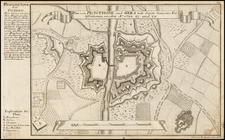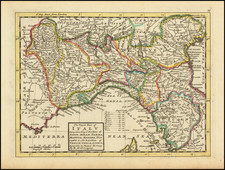This mid-17th century map, titled Il Bellunese Con Il Feltrino, provides a detailed depiction of the regions of Belluno and Feltre in northern Italy.
The regions of Belluno and Feltre have a rich history that dates back to ancient times. By the mid-17th century, these areas were part of the Republic of Venice, which exerted considerable influence over much of northeastern Italy. The map captures a time when these regions were significant both for their strategic locations and their contributions to the cultural and economic landscape of the Republic.
The map prominently features the rugged terrain of the Dolomite Mountains, which dominate the landscape of Belluno and Feltre. The Piave River, a major waterway in the region, is also depicted. This river played a crucial role in trade and transportation, linking the region to other parts of northern Italy.
Belluno, the capital of the province, has a history that stretches back to Roman times. Belluno's history is marked by its role as a Roman municipium and later as a fortified medieval town. Throughout the Renaissance, it flourished under Venetian rule, becoming a key administrative hub. The city’s strategic importance was underscored by its fortifications and its position as a link between the mountains and the Venetian plains. Belluno was also a center of cultural activity, with significant contributions to art and architecture. By the 17th century, it was an important administrative and military center within the Venetian Republic. The city was known for its strategic location at the edge of the Dolomites, serving as a gateway between the mountains and the plains. Belluno's notable landmarks included its cathedral and various Renaissance-era palaces.
Feltre, another significant city in the region, also boasts ancient roots. Feltre's history is similarly rich, with origins as a Roman settlement. Throughout the Middle Ages, it grew into a prosperous town known for its trade and industry. Feltre’s allegiance shifted between various powers, including the Holy Roman Empire and the Venetian Republic, reflecting its strategic value. The city was renowned for its skilled artisans and its vibrant market, which attracted traders from across the region. It was historically a center of commerce and craftsmanship, renowned for its wool and textile production. Feltre's strategic position made it a focal point in various military campaigns, particularly during the conflicts between the Venetian Republic and the Habsburgs. The city was home to several important architectural and cultural sites, including the Feltre Cathedral and numerous historic buildings.
Joan, or Johannes, Blaeu (1596-1673) was the son of Willem Janszoon Blaeu. He inherited his father’s meticulous and striking mapmaking style and continued the Blaeu workshop until it burned in 1672. Initially, Joan trained as a lawyer, but he decided to join his father’s business rather than practice.
After his father’s death in 1638, Joan and his brother, Cornelis, took over their father’s shop and Joan took on his work as hydrographer to the Dutch East India Company. Joan brought out many important works, including Nova et Accuratissima Terrarum Orbis Tabula, a world map to commemorate the Peace of Westphalia which brought news of Abel Tasman’s voyages in the Pacific to the attention of Europe. This map was used as a template for the world map set in the floor of the Amsterdam Town Hall, the Groote Burger-Zaal, in 1655.
Joan also modified and greatly expanded his father’s Atlas novus, first published in 1635. All the while, Joan was honing his own atlas. He published the Atlas maior between 1662 and 1672. It is one of the most sought-after atlases by collectors and institutions today due to the attention to the detail, quality, and beauty of the maps. He is also known for his town plans and wall maps of the continents. Joan’s productivity slammed to a halt in 1672, when a fire completely destroyed his workshop and stock. Joan died a year later and is buried in the Westerkerk in Amsterdam.









![(Lombardy) Alta Lombardia e stati ad essa circonuicini... [Upper Lombardy and adjacent states]](https://storage.googleapis.com/raremaps/img/small/92672.jpg)
![[Vercelli] Urbis Vercellensis a Carolo Emmanuele II](https://storage.googleapis.com/raremaps/img/small/89098.jpg)
![[Upper Lombardy and Surrounding Countries, where are the States of Savoy, Piedmont, Milan, Genoa, Montferrat, etc. . . 1648] Haute Lombardie et Pays circomvoisins, ou sont les Estats de Savoye Piemont, Milan.Genes, Monferrat, &c](https://storage.googleapis.com/raremaps/img/small/96129.jpg)

![[ Istria / Croatia ] Nouvelle Carte de L'Istrie Suivant le Plan dresse sur les lieux . . .1780](https://storage.googleapis.com/raremaps/img/small/37133.jpg)
